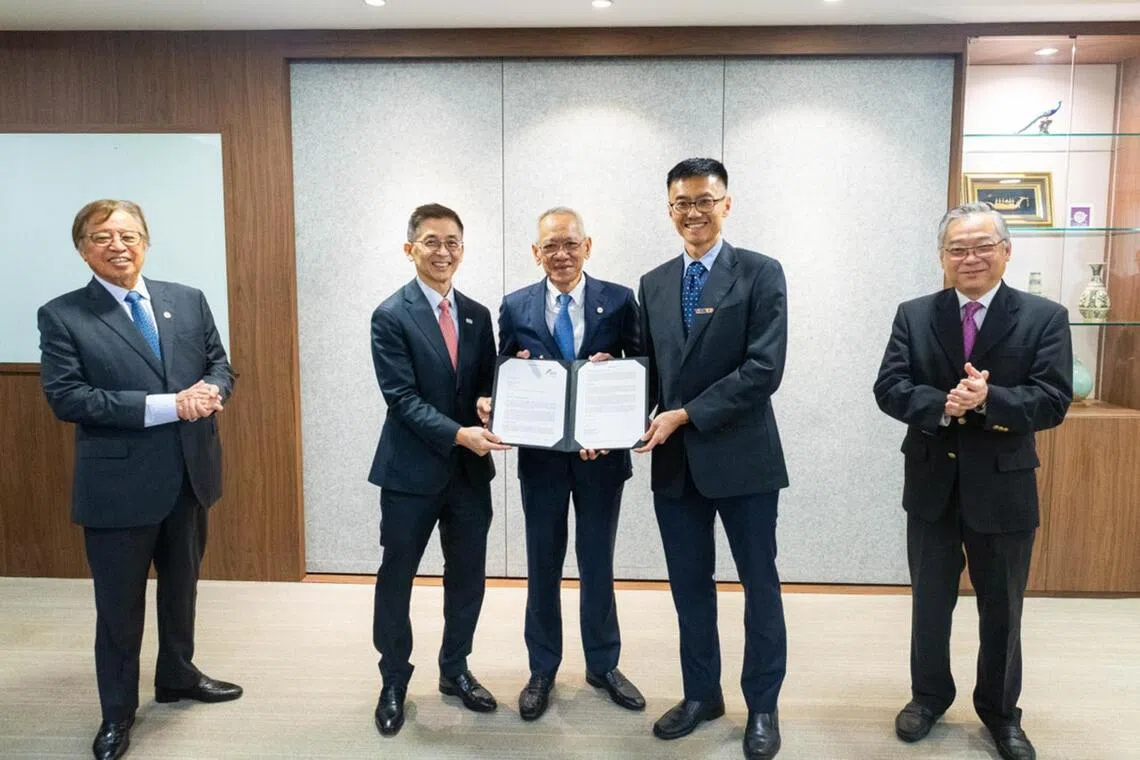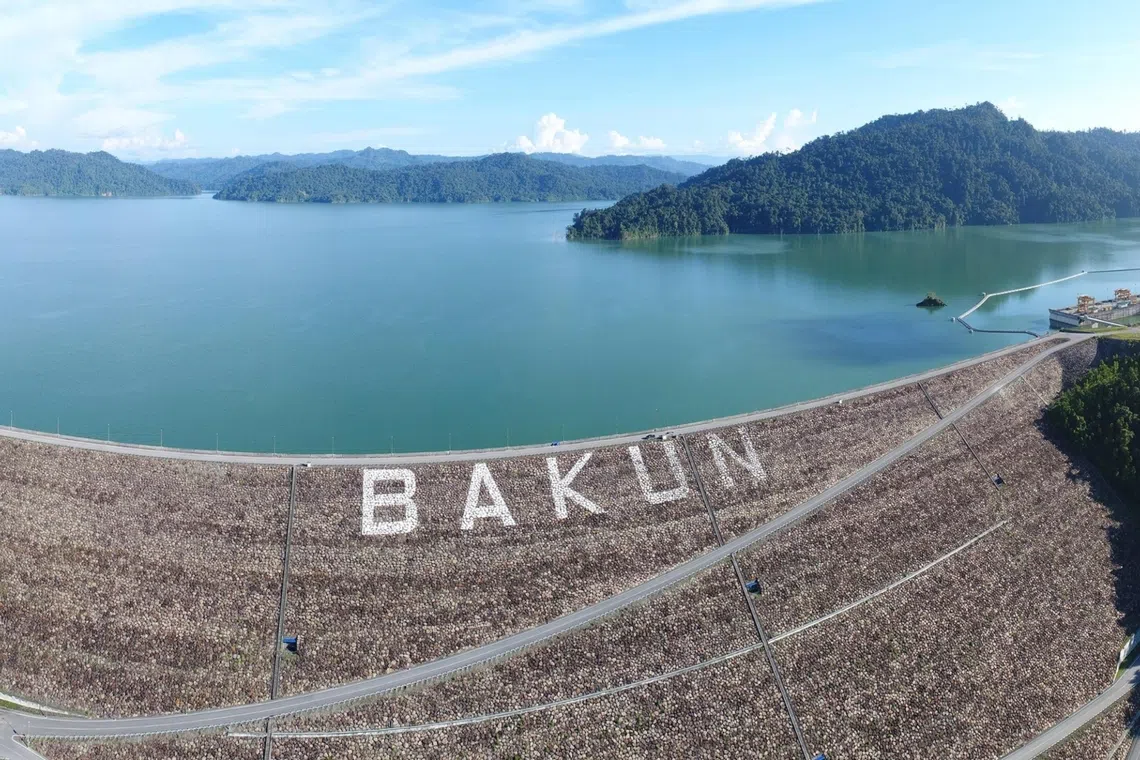Work on Singapore-Sarawak undersea power cables to start in 2026, says Sarawak minister
Sign up now: Get insights on Asia's fast-moving developments

Deputy Prime Minister and Minister for Trade and Industry Gan Kim Yong. (far right) and Sarawak Premier Abang Johari Tun Openg (far left) witnessing the awarding of the conditional approval to Sembcorp Utilities on Oct 17.
PHOTO: MTI
Follow topic:
SINGAPORE - The construction of undersea power cables to supply electricity from Sarawak to Singapore will start by 2026, said the Malaysian state’s Premier Abang Johari Tun Openg.
Speaking after launching the Sarawak Mega Fair at Suntec Singapore Convention and Exhibition Centre on Oct 16, the Sarawak Premier said the state and Singapore will sign an agreement on the purchase of power on Oct 17.
The Singapore and Malaysia governments have been in talks over transmitting 1GW of energy, mainly in the form of hydropower produced in Sarawak.
Datuk Johari said both sides are looking at a 2026 commencement date pending an ongoing shortage of submarine cables, which he is confident could be overcome by the end of 2025.
“Both the Singapore and Sarawak governments, with endorsement from the Malaysian government, (decided) that the cable construction has to start at least by next year,” he said.
On Oct 17, Singapore’s Energy Market Authority (EMA) said in a press release that it has granted conditional approval to Sembcorp Utilities, which is working with its consortium partner Sarawak Energy, to import 1GW of low-carbon electricity from Sarawak to Singapore.
“This marks a new phase of energy partnership between both nations,” said the EMA in the release.
The awarding of the conditional approval was marked by two ceremonies held on Oct 17 in Kuala Lumpur and Singapore.
Mr Johari witnessed the first ceremony in Singapore, along with Deputy Prime Minister and Minister for Trade and Industry Gan Kim Yong.
The second ceremony was witnessed by Malaysia’s Deputy Prime Minister Fadillah Yusof, who is also Minister of Energy Transition and Water Transformation, and Singapore’s Minister-in-charge of Energy and Science and Technology Tan See Leng, also Manpower Minister, on the sidelines of the 43rd Asean Ministers on Energy Meeting in Kuala Lumpur.
The EMA said it has preliminarily assessed the project proposal to be technically and commercially viable in supplying electricity from hydropower in Sarawak to Singapore.
“For the project to progress, the consortium will need to secure all requisite approvals from relevant jurisdictions, including countries which the transmission cables will pass through,” said the EMA.
“The conditional approval provides the consortium with regulatory support from EMA to continue to develop the project to meet its proposed commercial operation date, which is expected to be around 2035.”
Low-carbon electricity imports form a key part of Singapore’s strategy to decarbonise the power sector, which currently accounts for 40 per cent of the Republic’s carbon emissions.
Wire agency AFP earlier reported that Sarawak’s three hydropower plants currently produce around 3.5GW of electricity – enough to light about two to three million South-east Asian households daily.
A fourth hydropower plant is being planned,
With a population of just around 2.5 million, Sarawak is generating more power than it uses, allowing it to sell the surplus to its neighbours.
With 70 per cent of the 700km submarine cable set to be laid through Indonesian waters, Mr Johari said Jakarta is also keen to tap the scheme.
“Indonesia is quite positive on this, but they are still talking,” he said.
Meanwhile, Singapore and Malaysia have also agreed to conduct a full feasibility study of a second power interconnection between the Republic and Peninsular Malaysia with a potential capacity of 2GW.
This second interconnection aims to enhance energy cooperation between the two countries and expand the capacity for cross-border electricity trade.
The interconnection is targeted to start operations by 2030.

The Singapore and Malaysia governments have been in talks over transmitting 1GW of energy, mainly in the form of hydropower produced in Sarawak.
PHOTO: SARAWAK ENERGY
An agreement on the feasibility study was signed on Oct 17 by Malaysian utility company Tenaga Nasional, Singapore’s national grid operator SP Group and Singapore Energy Interconnections, a company appointed by the Government to develop and run cross-border electricity interconnections to enable power imports into Singapore.
“The upcoming feasibility study for the second Malaysia-Singapore interconnection is a crucial step towards expanding cross-border electricity trade,” said Tenaga Nasional chief executive Megat Jalaluddin Megat Hassan.
The first interconnection between the two countries was established in 1983 with the primary purpose of supporting both countries’ power grid.
In 2022, it was upgraded to allow for bidirectional electricity flows of 1GW. It currently supports two cross-border electricity trade projects – the Lao PDR-Thailand-Malaysia-Singapore Power Integration Project and the Energy Exchange Malaysia pilot project.
Sign up for our weekly
Asian Insider Malaysia Edition
newsletter to make sense of the big stories in Malaysia.


